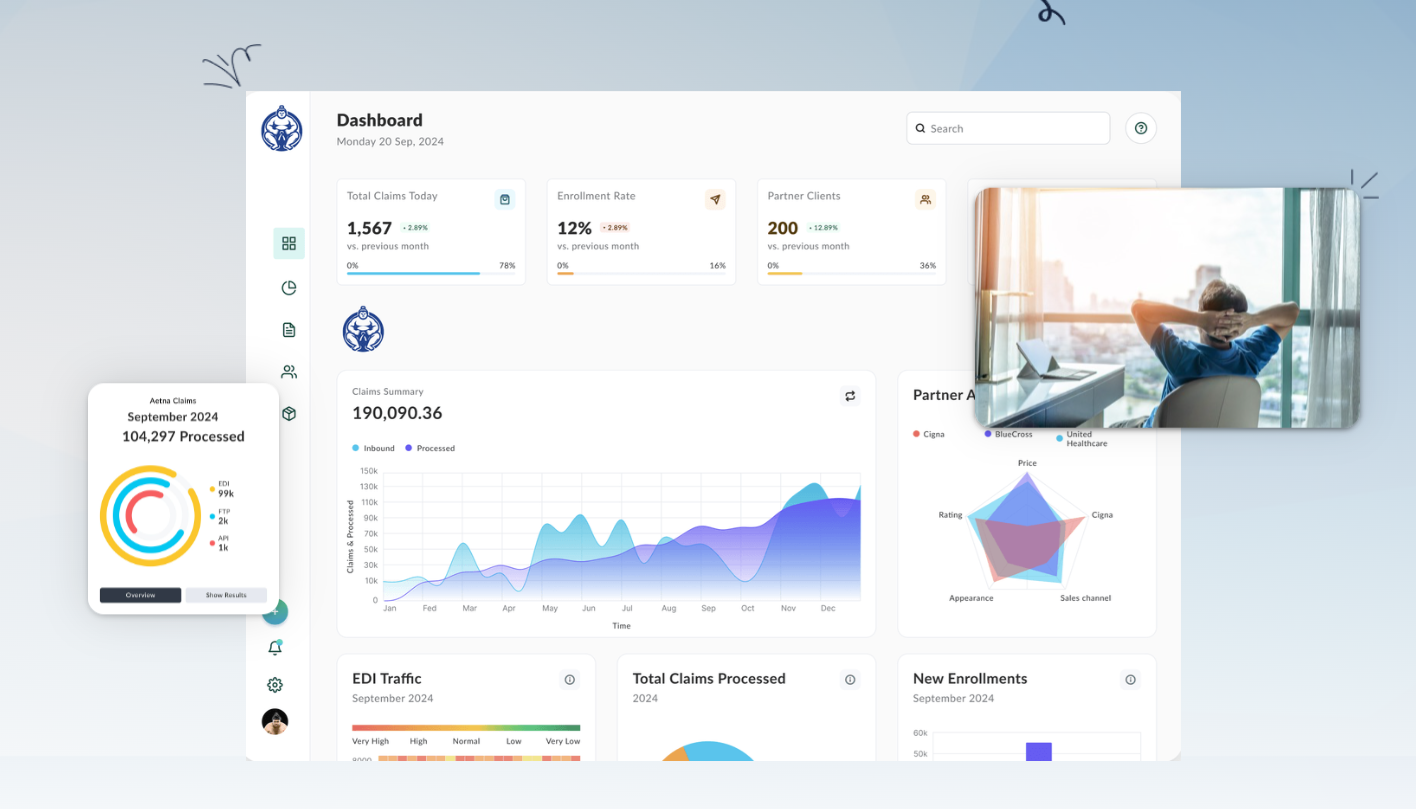The Real Costs of Delayed Claims Processing in Healthcare Insurance—and How to Reduce Them


In the world of healthcare insurance, speed and accuracy in claims processing isn’t just about keeping members happy—it’s about preserving financial health, meeting compliance standards, and protecting your brand’s reputation. At EDI Sumo, we interact daily with payers who experience first-hand the ripple effect of delayed claims processing. Let’s take a deep dive into the real costs these delays create, and outline practical, tech-driven strategies to turn the tide for your organization.
Understanding the Downstream Effects of Delayed Claims Processing
When claims are held up—whether by data issues, processing bottlenecks, or system limitations—costs accrue on several fronts. Here's how delays can impact your bottom line and organizational performance:
- Financial Penalties & Revenue Leakage: Missed contractual SLAs can lead to hefty penalties from providers and partners. Lingering claims delay premium revenue recognition and slow down cash flow, putting a strain on accounts receivable.
- Operational Overhead: Manual interventions, rework, and follow-up communications spike when claims lag behind. These compensatory efforts drain both IT and customer service resources.
- Degraded Member & Provider Experience: Members notice when benefits and reimbursements are slow. Providers’ trust in your reliability wanes, sometimes driving them to escalate or even seek new payer partners.
- Compliance & Audit Risks: Inaccuracies and process gaps are easy targets during audits. Delays in claims can surface as HIPAA, regulatory, or SLA breaches, opening the door to compliance violations and legal exposure.
- Data Integrity and System Strain: Bottlenecks at one end cause batches of claims to flood downstream systems later, triggering spikes that test infrastructure—and often break it.
Why Delays Happen: Pinpointing the Root Causes
Let’s face it: healthcare EDI is complicated by arcane file formats, manual mapping, fragmented legacy systems, and a host of error-prone handoffs. Based on real-world experience supporting payers, we’ve noticed the most common culprits:
- Format Inconsistencies: Files like EDI 837s, CSVs, and XML can each bring unique quirks—missing fields, nonstandard codes, or invalid loops.
- Manual Processing & Data Entry: Too much time is spent reconciling data by hand, leading to errors or unresolved exceptions that stall progress.
- Lack of Real-Time Monitoring: Without live visibility, it can take hours—or days—to discover an error or backlog.
- Slow Error Detection: By the time a problem is spotted, rework is needed across multiple teams and systems, compounding delays.
- Poor Integration: Even the best internal systems can create roadblocks if your EDI isn’t seamlessly flowing into claims management, customer service, or compliance tracking systems.
Quantifying the Impact: What’s Really at Stake?
Although every organization’s numbers differ, we’ve observed repeatable patterns among payers who rely heavily on manual or outdated EDI processes:
- Penalty Exposure: Some clients at EDI Sumo have faced millions in potential SLA penalties annually attributable solely to delayed claims.
- Escalating Operating Costs: When IT and operations spend more time firefighting claims issues, direct costs can rise by 20–30%—often eating into profit margins.
- Member & Provider Attrition: The membership journey is fragile. A series of delayed or mishandled claims is enough for a significant portion of members or providers to consider other options at renewal time.
- Compliance Threats: With HIPAA and other governing bodies expecting prompt and accurate data handling, a pattern of process delays puts you squarely in the audit crosshairs.

Turning the Ship: Strategies to Minimize Delayed Claims Costs
Solving these challenges requires a shift toward automation, integration, and visibility at every touchpoint. Here’s how our healthcare payer clients are winning the battle against claims delays:
1. Standardize and Validate on Ingest
- Multi-Format Normalization: Stop hand-coding transformation rules for every enrollment or claims file. Automate the translation and validation of all major inbound formats (EDI 837, 834, CSV, XML, and more) at the edge.
- Automated Data Quality Rules: Implement high-fidelity validation before claims hit your internal systems. This nips errors in the bud, creating clean data and reducing reconciliation downstream.
2. Real-Time Monitoring & Alerts
- Continuous Tracking: Know exactly when and where claims files enter, get processed, or encounter problems. Proactive alerts turn hours of lag into near real-time response.
- Unified Dashboards: One-stop visibility into claims processing status, file histories, and trending bottlenecks helps IT and operations act before SLAs are put at risk.
3. Streamline Error Detection and Correction
- Automated Error Handling: Route and resolve standard errors quickly without human intervention. Reserving staff for only the most complex exceptions shortens turnaround and saves labor costs.
- Immediate Discrepancy Alerts: Notifying responsible parties instantly about file or data mismatches prevents errors from snowballing into multi-day delays.
4. Seamless System Integration
- All-in-one Data Flow: Break down silos by connecting your EDI layer directly to claims management, member enrollment, and customer service applications.
- Role-Based Access: Empower business users and customer support teams with direct, controlled access to eligibility records and claims data.
- Historical Data & Audit Trails: Maintain an audit-ready record of every processing step and user interaction for compliance, review, and troubleshooting.
The Human Side: Enhancing Member and Provider Experience
We must never forget that the claim at the center of your workflow isn’t just a transaction—it’s a member, a patient, or a family counting on timely support. When your organization expedites claims processing:
- Members receive care and reimbursement more swiftly, reducing anxiety and building trust.
- Providers spend less time fielding status calls, improving satisfaction and partnership opportunities.
- Customer service teams resolve issues on the first call more often, fueling loyalty and positive word-of-mouth.
The Role of Modern EDI Tech: What We’ve Learned at EDI Sumo
Our vantage point—spanning health, dental, and vision payers—shows it’s not just about digitizing. It’s about empowering both IT and business teams with tools that normalize, validate, and route clean data whenever and wherever it enters your org. The biggest results we’ve delivered together with clients aren’t just about compliance—they’re about transforming from reactive to proactive.
- Reduction in SLA Penalties: Clients have documented major savings by simply being able to spot and fix blocked claims in real time—some have sidestepped millions in downstream penalty fees.
- Improved Cash Flow: Faster claims cycles accelerate revenue and reduce receivables aging.
- Operational Uplift: We’ve seen up to 30% reduction in EDI ops costs when orgs empower support roles, automate mapping, and centralize error handling.
- Audit Resilience: Always-on audit trails and compliance dashboards take the pain out of annual reviews, reducing both the time and stress involved for all staff tiers.
Practical Next Steps for Payers and IT Leaders
For CIOs, IT Directors, and claims or enrollment managers, tackling delays in the claims cycle is both a technical challenge and an opportunity for business impact. Here’s where to start:
- Assess your current claims processing lag: Where are bottlenecks most frequent? Which steps require the most manual intervention?
- Review your EDI strategy: Are you still relying on lots of custom scripts, disjointed platforms, or manual data mapping?
- Engage your business users: What would it mean for support, compliance, finance, and member experience if they had real-time visibility into claims data?
- Pilot automation where risk and cost are highest: Don’t try to rip and replace. Start by integrating automated validation, monitoring, and error detection around your most error-prone sources.
Final Thoughts: Turning Delays Into Strategic Wins
Delayed claims aren’t just a technical headache—they seep value and goodwill from every part of the healthcare insurance ecosystem. Forward-looking payers are making targeted investments in automation, visibility, and flexible integrations, and seeing operational excellence as the result.
If you're ready to transform your organization’s approach to claims management, learn more about our solutions here. Or, if exploring seamless EDI integrations across enrollment, claims, and customer service is your next big step, discover more about how integration harmony with EDI Sumo can help you simplify and accelerate data flow.
For a tailored walkthrough, schedule a demo with our team—let’s reduce your real costs and unlock the power of proactive claims processing together.


.png)





.png)

.png)


.png)
